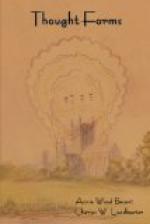On Meeting a Friend.—Fig. 35 gives us an example of a good, clearly-defined and expressive thought-form, with each colour well marked off from the others. It represents the feeling of a man upon meeting a friend from whom he has been long separated. The convex surface of the crescent is nearest to the thinker, and its two arms stretch out towards the approaching friend as if to embrace him. The rose colour naturally betokens the affection felt, the light green shows the depth of the sympathy which exists, and the clear yellow is a sign of the intellectual pleasure with which the creator of the thought anticipates the revival of delightful reminiscences of days long gone by.
[Illustration: FIG. 35. ON MEETING A FRIEND]
The Appreciation of a Picture.—In Fig. 36 we have a somewhat complex thought-form representing the delighted appreciation of a beautiful picture upon a religious subject. The strong pure yellow marks the beholder’s enthusiastic recognition of the technical skill of the artist, while all the other colours are expressions of the various emotions evoked within him by the examination of so glorious a work of art. Green shows his sympathy with the central figure in the picture, deep devotion appears not only in the broad band of blue, but also in the outline of the entire figure, while the violet tells us that the picture has raised the man’s thought to the contemplation of a lofty ideal, and has made him, at least for the time, capable of responding to it. We have here the first specimen of an interesting class of thought-forms of which we shall find abundant examples later—that in which light of one




